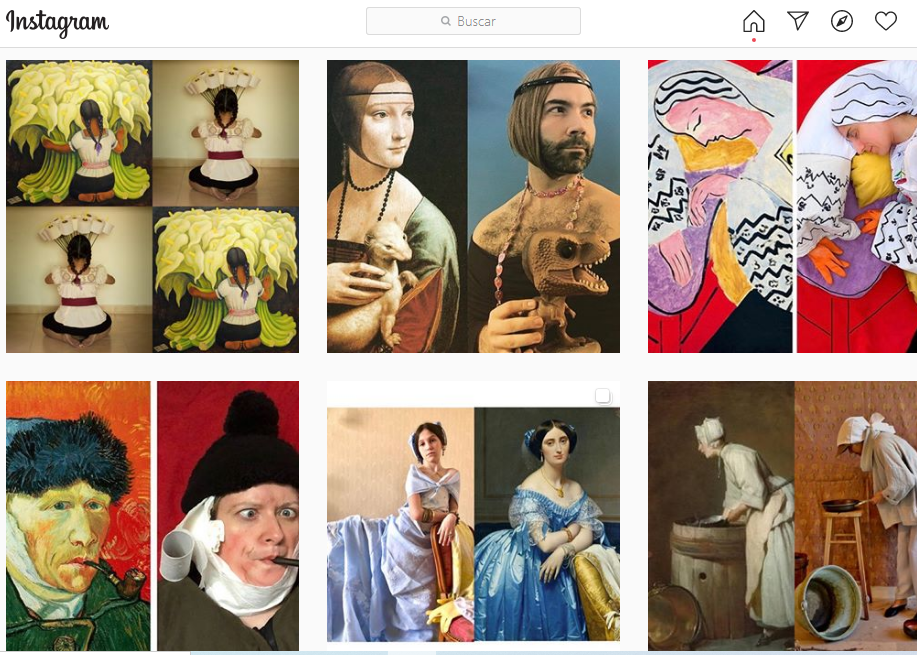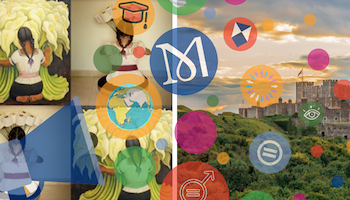ICOM Voices is the new editorial space created by ICOM, to encourage the exchange of experience and expertise among museum professionals.
ICOM Italia is pleased to share two new interesting articles, on the topics of digital museums communication and agile interpration of the heritage.
As Personal as Viral: Reinventing Museum Communication
by Ainhoa Simón Diez, Technical Specialist, member of the Corps of Museum Curators of Spain
Original text on ICOM International webite
The COVID-19 health crisis and its consequences have upended how we socialise. The digital world has come (even further) to the forefront of our lives: telecommuting, online learning, shopping, and entertainment, giving birth to an online ‘here and now’ that, of course, museums must fully participate in.
The social distancing measures this new scenario requires have acted as a catalyst for some of the online socialising we had already caught sight of before the pandemic. Social media statistics and reports collected throughout 2019 and 2020, and published by leaders in the sector such as Hootsuite, We Are Social or GlobalWebIndex, show, among other trends, that mass communication has become less relevant when compared to other more personalised, bespoke options. This reveals an increase in the value assigned to user-generated content.
New Codes to Reinforce the Museums’ Digital Communities
When applied to museum communication, the first trend – the decrease of mass communication favouring more personalised options – requires that we become acquainted with the profile of the communities and users of each digital channel and, in turn, it demands that we adapt our content so it matches these profiles. A good example of this strategy is the British Museum’s YouTube Channel, which has a section called Curator’s Corner, chosen by users from among four different proposals pitched in 2015, when the channel was re-launched. The section has a video format reminiscent of the one that made vloggers, also known as youtubers on the platform, popular. This format has allowed curators to showcase their work in an informal and straightforward fashion, while reinventing the blog twofold: firstly, by introducing video as the cornerstone of communication, and secondly, by using platforms such as YouTube. This has allowed the museum to periodically share theme-based content geared towards a specific audience in personalised, engaging way.
Sincerity, and proximity are what social media users value most. Accounts that communicate in this manner are perceived as ‘more real,’ and users interact with them more often. An example of this is micro-influencers, that is, users who are relevant in a community that is smaller than that of their better-known siblings, the influencers. On average, a micro-influencer can accrue some 10,000 followers, whereas the most famous influencers can have well over 100 million. A small community allows a micro-influencer’s follower to truly feel they are a part of a tightly knit community and, in turn, to identify more strongly with the community’s message, which makes it more believable. While in museums this terminology is not commonly used, there are social profiles that have a considerable influence in their field. A good example is @MarDixon, the brain behind such social media campaigns as #MuseumSelfie and #AskACurator, among others. The success of social profiles beyond the museum world reveals that, in the universe of social media, users are not an audience and do not behave as such. Thus, museums must strive to become relevant to their followers; success is no longer gauged by the number of interactions, but rather by the quality of the communication in question.
New Ways of Engaging the Newer Generations
The second trend mentioned at the start of this article – the greater importance given to the content generated by the user – is driven by a generation native to the digital world that has embraced social media to an extent that that will affect their future in unforeseen ways. Gen Z has chosen video as their go-to format and has applied the foundations of ephemeral culture to their content; they have taken words and replaced them with emojis while making creativity their calling card.
These changes have been key to the success of certain social networks, such as TikTok, Instagram, F3, or Snapchat. These platforms place the user under the limelight: no longer limiting themselves to consuming content, they actually have become content generators. Viral challenges are the best example of a result of these trends.
Clearly, rethinking a museum’s digital communication strategy entails opening up new channels and new modes of expression that will allow the institution to reach out to the younger generations, encouraging them to create content. A good example of abiding by these new rules was the #GettyMuseumChallenge, started by the Los Angeles Getty Museum, which, during lockdown and by using the aforementioned hashtag, challenged users to recreate works of art at home. The idea drew from the @tussenkunstenquarantaine Instagram account, where online users collaborated by uploading their versions of works of art with the #tussenkunstenquarantaine and #betweenartandquarantine hashtags. The MuseumWeek added this challenge to their 2020 program with their #CultureInQuarantine hashtag.

These emerging social trends enable new ways of establishing a connection with users. They also offer an opportunity to reinvent museum communication, by developing a new relationship with the visitor, one that calls for more participation and visitor decision-making.
These changes must be implemented as part of a carefully planned digital strategy that relies on suitable human and technological resources. Otherwise, museums will struggle to adapt to the changes social media require.
Responding to COVID-19: Agile Interpretation at English Heritage
by Dr Dominique Bouchard, Head of Learning and Interpretation, English Heritage, UK
Original text on ICOM International webite
English Heritage cares for over 400 historic buildings, monuments and sites across England, from famous ancient sites including Stonehenge and Hadrian’s Wall to a Cold War Bunker de-commissioned in the 1990s. COVID-19 affected our operations dramatically, from closing hundreds of sites to furloughing more than 86% of staff.
The visitor experience was at the heart of our response, and we focused our efforts on making the most of the National Heritage Collection during lockdown through digital-led initiatives. These programmes became part of a new strand of work, Agile Interpretation.

Agile Interpretation is English Heritage’s new programme of visitor-focused, responsive, low-cost interpretative interventions, designed to support enriched visitor experiences at our sites. It began as a crisis management approach, but we realised quickly that it offered a way to think differently about interpretation, emphasising rapid turnaround and innovation. Today, Agile Interpretation forms a key part of English Heritage’s ongoing strategy.
How it began
On 18 March 2020, when English Heritage closed all of our paid entry sites, the Agile Interpretation programme was established to ensure high-quality access during lockdown to the National Heritage Collection through three digital-led initiatives: improving online historical content, enhanced history pages for Free-to-Enter sites (which remained open briefly when restrictions began), and home learning.
At first, this meant creating new digital content and identifying fresh ways to support home learning. However, the biggest challenge was to minimise the impact on visitors when sites eventually re-opened. Some areas of sites would remain inaccessible, and key elements including handheld audio guides and interactives would be affected, if not withdrawn entirely. As official guidance was susceptible to change, any plans would need to be flexible and responsive.
On-site Agile Interpretation
Keeping visitors, volunteers and staff safe was our top priority. Ensuring safety required a comprehensive review of how people visit and work at our sites. Due to social distancing, access to some areas of sites would be restricted, limiting interpretation or creating gaps in storytelling. Two Agile Interpretation initiatives, ‘Dynamic Visitor Routes’ and a project to transfer all our audio guides from handheld units to Bring Your Own Device (BYOD), were considered to have the greatest short-term impact whilst potentially also having longer-term relevance.
Seven new panel templates were created; each had a QR code and simple text to indicate the type of content accessible by scanning the code. The panels Watch, Listen, Family Fun, Look Inside, Explore the Collection, and Find Out More, could be used at any site, and hinted at the kind of content the code might reveal whilst maintaining a sense of discovery. Deployed as part of the Dynamic Visitor Route programme, the new panels were intended to help bridge gaps in on-site storytelling or give digital access to restricted areas, and could be moved or removed easily.
Dynamic Visitor Routes
We believed that a dynamic approach to visitor routes would allow us to accommodate either a relaxation or tightening of restrictions, yet how to do that whilst also ensuring a coherent on-site narrative was not obvious. Some exploratory conversations with architects at University College London suggested a ‘space syntax’ approach could be valuable. ‘Space syntax’ is a spatial analysis approach that represents and compares the way people move through complex, interlinked spaces, and complexes. Initial assessments showed that visitor routes would need to be re-thought for 100+ sites: an enormous challenge! We re-modelled how visitors could move around sites, identifying ‘nodes’, locations where visitors make key decisions about their journey, and focused on these locations for the Agile Interpretation panels.
For example, Dover Castle’s famous Wartime Tunnels, the staging post for the Dunkirk evacuation in World War II, needed to remain closed as social distancing would be impossible. To help visitors explore this important history, temporary Agile Interpretation panels at the entrance to the Tunnels gave visitors access to exciting multimedia content created in May 2020 for the 75th anniversary of the Dunkirk evacuation helping to bring the story of the Tunnels to life.
BYOD Audio Guides
Typically, handheld audio guides are included with the price of admissions and so take-up of guides at our sites is between 40-60%. COVID-19 meant that even if handsets could be handed out safely, many visitors might not feel confident borrowing an audio guide, thus significantly impairing visitors’ access to the full interpretation available at a site. To address this and as part of the Agile Interpretation project, all of English Heritage’s handheld audio guides were converted to a BYOD model. In order to maximise visitors’ ability to choose a BYOD format that best suited their needs, we offered free downloadable guides via a native app (Guide-ID’s Podcatcher) and a Progressive Web App (PWA). A download code for the audio guide is included when purchasing a ticket; for visitors who either forgot to pre-download a guide or only decided to use an audio guide once they’ve arrived on site, a QR code at the site’s entrance directs visitors to the PWA, which streams individual audio guide stops, avoiding the need to download or store anything. Audio guide handsets are also available at sites that are able to distribute them safely.
The future of Agile Interpretation
Although Agile Interpretation started as a crisis management programme to minimise the disruption to visitors’ experience of our sites as well as respond to rapidly changing health guidance, it has quickly become a new and exciting approach for interpretation at English Heritage. Through the challenges posed by COVID-19, we have become more open to challenging ourselves to be nimbler and more responsive, improve our cross-departmental working practices, and focus more closely than ever on ensuring our visitors have memorable experiences. Agile Interpretation has demonstrated the potential of small-scale, temporary, and low-cost measures that prioritise visitors, and empower staff to be experimental and playful.
